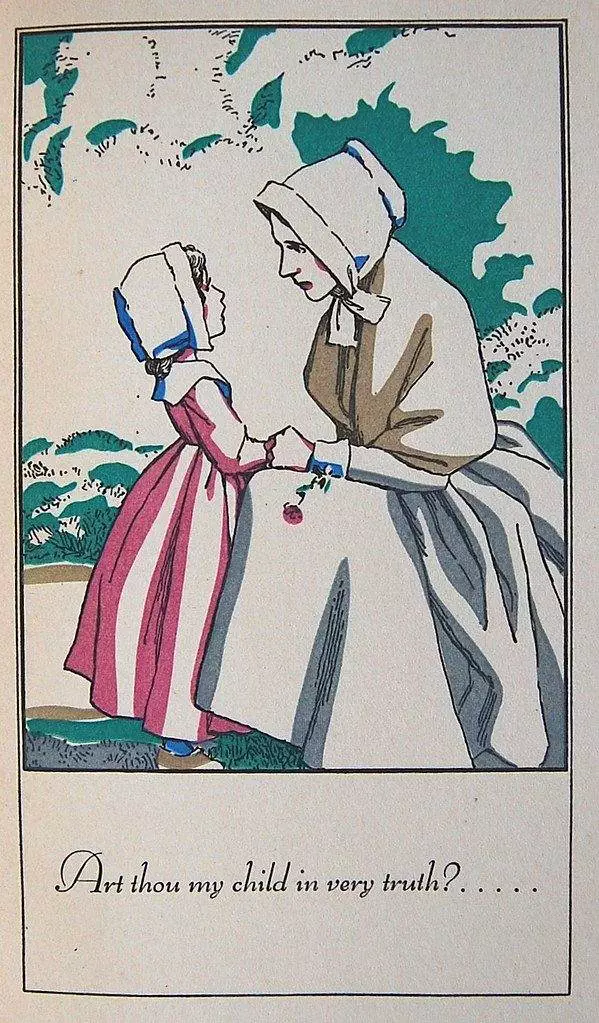Published in 1850, The Scarlet Letter by Nathaniel Hawthorne is a classic American novel set in puritanical 17th century Boston. It tells the story of Hester Prynne, a woman punished for committing adultery and bearing a child out of wedlock. She is forced to wear a scarlet letter “A” on her dress as a mark of shame. A psychological tale of guilt, desire, judgment, and salvation, The Scarlet Letter probes the effects of rigid morality and persecution on individuals and the community.
Table of Contents
Plot Summary
In colonial Boston, Hester Prynne is led in public punishment for committing adultery and having a baby. She refuses to name the father but is forced to embroider a scarlet “A” on her clothes. Her husband Roger Chillingworth arrives and vows revenge against her secret lover.
The village minister Arthur Dimmesdale agonizes over his undisclosed sin. Chillingworth moves in with him under the pretext of medicine and suspects Dimmesdale is Hester’s lover. Over seven years, Dimmesdale’s health declines as Chillingworth torments him psychologically. Meanwhile, inspired by her daughter Pearl, Hester lives a quiet life helping others. Ultimately Dimmesdale confesses publicly and dies in Hester’s arms on the scaffold. This redeems Pearl’s soul and Hester then leads a self-sufficient life.
Themes and Analysis
Major themes depicted in the novel:
- Hypocrisy in morality and nature of sin
- Public shaming and punishment versus private guilt
- Coming of age and developing personal identity
- Redemption through truth and suffering
- Psychological effects of secrecy and repression
- Strength of female solidarity and maternal love

Hawthorne used romantic, symbolic writing styles to explore Puritanism’s dark legacy. The scarlet letter represents duality – crime and courage. Through the reactions it provokes, he studies mass mentality versus inner morality. His empathy for Hester’s social isolation critiques patriarchal control and gender double standards.
Read These Too:
Pearl embodies the new generation who can overcome past repression. Hawthorne created psychologically complex characters constrained by their times and beliefs.
Puritanism and Nathaniel Hawthorne
Nathaniel Hawthorne descended from Puritan settlers in Salem, Massachusetts where the witch trials took place. He set tales in colonial New England exploring the burdens of guilt and sin.
Relevant historical context includes:
- Puritan settlers founding colonies based on religious purity
- Rigid moral and gender codes enforced legally and socially
- Public spectacular punishments used to reinforce norms
- Salem witch trials stoked mass hysteria and finger-pointing
- Impact of original sin doctrine on collective psyche
- Multi-generational effects of repression and dogmatism
As an early psychological novelist, Hawthorne probed the dark side of American history and humanity. He added deeper philosophical dimensions to literary romance genres.
Analysis of Characters
Hester Prynne – The shunned adulteress forced to wear the scarlet letter but transforms it into a symbol of feminine strength and self-reliance.
Pearl – Hester’s wild, elf-like illegitimate daughter who cannot conform and represents untamed female spirit.
Reverend Dimmesdale – The minister who fathered Pearl but hides his sin, is tortured by guilt and seeks belated redemption.
Roger Chillingworth – Hester’s forgotten elderly husband who returns to torment Dimmesdale as an embodiment of toxic masculinity.
Governor Bellingham– The harsh Puritan magistrate who enforces Hester’s punishment and tries to take Pearl away.
Mistress Hibbins – A bitter woman believed to be a witch who sympathizes with Hester’s oppression.
Read These Too:
Legacy and Impact
As a foundational American novel, The Scarlet Letter had immense influence:
- Critiqued historical Puritan moral absolutism and gender prejudice.
- Sympathetic portrayal of a “fallen woman” was groundbreaking.
- Hester Prynne established the archetype of the shunned heroine who redeems herself.
- Pearl represents inquisitive female nature and resilience of youth.
- Hawthorne pioneered the psychological historical romance.

- His allegorical style and symbolism became widely imitated.
- Scarlet letter “A” itself became iconic in popular culture.
- Inspired classics exploring moral gray areas like The Awakening, The Great Gatsby.
- Opened discussions on public punishment versus private conscience.
- Hester’s self-sufficient life choices prefigured feminist literature.
Why Read The Scarlet Letter
Here are some key reasons for the novel’s acclaim and significance:
- Hawthorne’s eloquent, haunting romantic Gothic prose.
- Psychologically complex portraits of repression and desire.
- Hester Prynne is an unforgettable defiant heroine.
- The drama of concealed sin and public humiliation.
- Masterful study of mass mentality and morality.
- Pearl’s wild character embodies untamable female nature.
- Ambiguous, darkly conflicted characters confronting rigid morality.
- Historical accuracy about Puritan settlements and beliefs.
- Timeless insights into emotions like guilt, judgment, redemption.
- gripping tale of an individual persecuted by the community and defending personal principles.
Conclusion
Nathaniel Hawthorne’s allegorical masterpiece set a new standard for American fiction with its multilayered psychological drama. The Scarlet Letter remains disturbingly relevant in its depiction of public shaming and gender double standards. Yet Hester Prynne’s compassion and quiet rebellion against conformity shine as a transcendent story of a woman ahead of her time.


